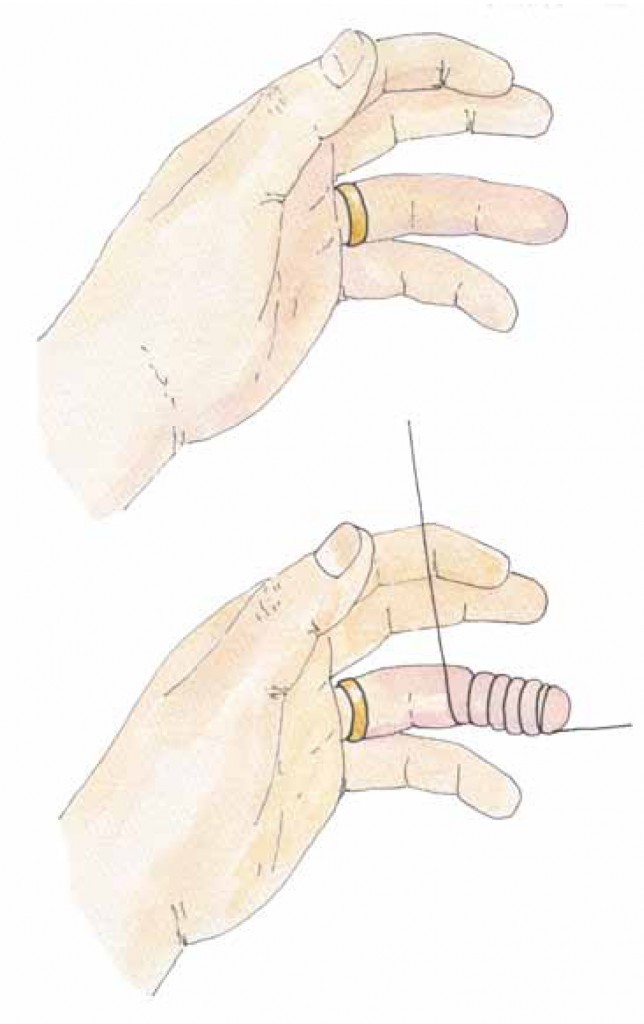In this issue of the WMNL, we will continue with the parasitic tapeworms, Cestoda, that can infect humans and cause significant illness and even death. Specifically, we will review the tapeworms in the genus Echinococcus
It seems like everyone who goes to the doctor with a wound or animal bite is asked when their last tetanus shot was. The question is why? What is so special about tetanus? What is it, and why do we care?
Tetanus, also knows as lockjaw, is a potentially fatal illness that occurs with wound infections. Tetanus is a neurologic disorder caused by the bacterial Clostridium tetani.
Clostridium tetani is an anaerobic bacterium that has the ability to form spores when in a hostile environment. When the bacterium is in a favorable environment to survive, thrive, and multiply, it exists as a single-celled bacterium that feeds, multiplies, and excretes. When the bacterium finds itself in a hostile environment, it changes into a spore with a hard outer, protective shell. As a spore it can survive the hostile environment for up to 40 years, just waiting for the opportunity to move into a more favorable milieu.
https://www.wildernessmedicinenewsletter.com/wp-content/uploads/2014/10/wmnlogo20151.png00WMN Editorshttps://www.wildernessmedicinenewsletter.com/wp-content/uploads/2014/10/wmnlogo20151.pngWMN Editors2011-05-10 19:46:132011-12-06 16:15:56WOUNDS AND THE RISK OF TETANUS
While on a recent trip to a Caribbean island, I couldn’t help but notice the amount of highly toxic, hallucinogenic plants growing along the roadways. Most were in full bloom, bearing fruit, and seeds. A little on-line research quickly established exactly how common the problems are with these remarkably poisonous plants, and that severe illness and death were not unusual.
There are two problems with rings on swollen fingers: the finger and the ring.
The primary problem is the swollen, tender finger. It can be swollen for a variety of reasons, most commonly because of minor trauma that sprained the finger causing it to swell. The other problem is the ring itself and what it is made of. If it is gold, silver, nickel, or brass, then one of the options is to simply cut the ring and have it repaired by a jeweler, assuming that you have a ring cutter to begin with. The real problem occurs with rings that are made out of very hard metals, such as titanium, which are popular wedding bands these days. The difficulty is simply that you are not going to cut through a titanium ring with a ring cutter.
CESTODA – ECHINOCOCCUS
/in Parasites/by WMN EditorsMay/June 2011 ISSN-1059-6518 Volume 24 Number 3
By Frank Hubbell, DO
Cestoda –
Echinococcus:
In this issue of the WMNL, we will continue with the parasitic tapeworms, Cestoda, that can infect humans and cause significant illness and even death. Specifically, we will review the tapeworms in the genus Echinococcus
Read more
WOUNDS AND THE RISK OF TETANUS
/in Immunizations, Medications, prevention/by WMN EditorsMay/June 2011 ISSN-1059-6518 Volume 24 Number 3
By Frank Hubbell, DO
Wounds and the Risk of Tetanus
Clostridium tetani and Tetanospasmin
It seems like everyone who goes to the doctor with a wound or animal bite is asked when their last tetanus shot was. The question is why? What is so special about tetanus? What is it, and why do we care?
Tetanus, also knows as lockjaw, is a potentially fatal illness that occurs with wound infections. Tetanus is a neurologic disorder caused by the bacterial Clostridium tetani.
Clostridium tetani is an anaerobic bacterium that has the ability to form spores when in a hostile environment. When the bacterium is in a favorable environment to survive, thrive, and multiply, it exists as a single-celled bacterium that feeds, multiplies, and excretes. When the bacterium finds itself in a hostile environment, it changes into a spore with a hard outer, protective shell. As a spore it can survive the hostile environment for up to 40 years, just waiting for the opportunity to move into a more favorable milieu.
Read more
Witches Weeds
/in Poisons/by WMN EditorsMay/June 2011 ISSN-1059-6518 Volume 24 Number 3
By Frank Hubbell, DO
“WITCHES WEEDS”:
While on a recent trip to a Caribbean island, I couldn’t help but notice the amount of highly toxic, hallucinogenic plants growing along the roadways. Most were in full bloom, bearing fruit, and seeds. A little on-line research quickly established exactly how common the problems are with these remarkably poisonous plants, and that severe illness and death were not unusual.
Read more
Removing Rings
/in hands, Treatment/by WMN EditorsMay/June 2011 ISSN-1059-6518 Volume 24 Number 3
By Frank Hubbell, DO
Illustrations by T.B.R. Walsh
Removing Rings
How do you get a ring off a swollen finger?
There are two problems with rings on swollen fingers: the finger and the ring.
The primary problem is the swollen, tender finger. It can be swollen for a variety of reasons, most commonly because of minor trauma that sprained the finger causing it to swell. The other problem is the ring itself and what it is made of. If it is gold, silver, nickel, or brass, then one of the options is to simply cut the ring and have it repaired by a jeweler, assuming that you have a ring cutter to begin with. The real problem occurs with rings that are made out of very hard metals, such as titanium, which are popular wedding bands these days. The difficulty is simply that you are not going to cut through a titanium ring with a ring cutter.
Read more